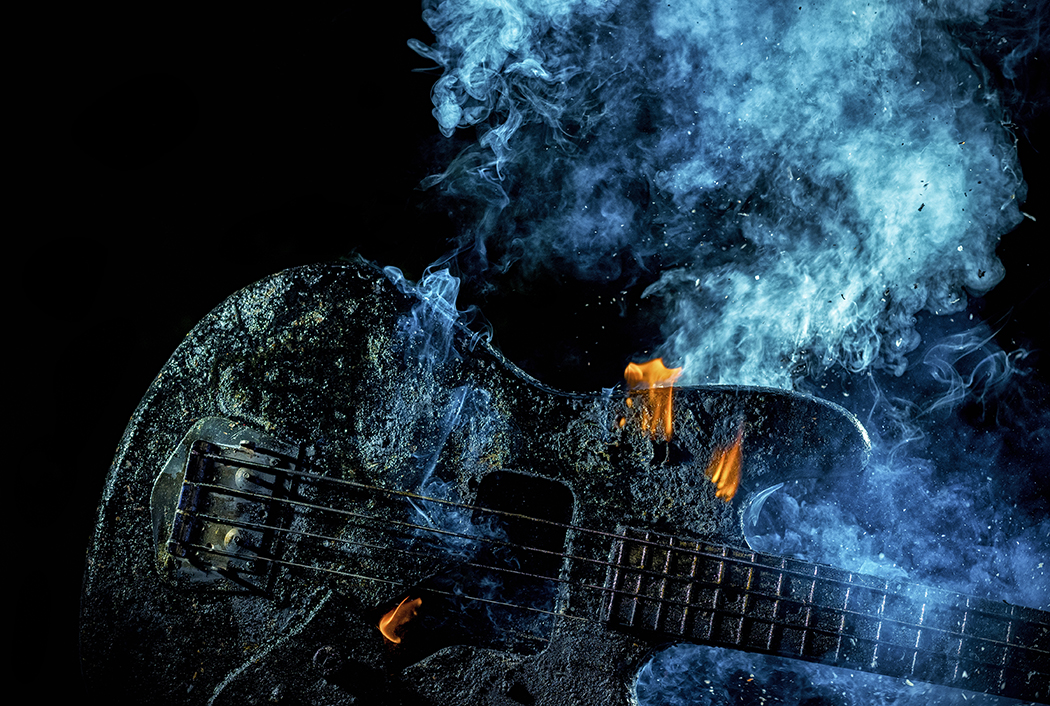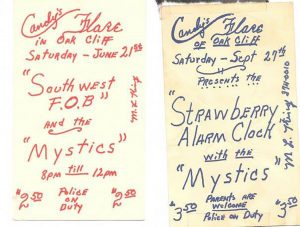
(Photo by Danny Fulgencio)
When Oak Cliff Rocked
When Jimmie Vaughan joined The Chessmen in the mid-1960s, his Kimball High School buddy Danny Sanches took over as guitar player in Vaughan’s previous band, The Pendulums.
“Jimmy and I used to practice at his parents’ house,” Sanches recalls. “He got me up to speed on some of the songs they were playing, and we’d put records on the turntable and pick parts out of it.”
The first one he learned that way was The Yardbirds’ “The Nazz are Blue,” Sanches says.

Clockwise from top left: An Oak Cliff band performs at a school dance, Stevie Ray Vaughan, right, with John Michael Soria, the Sounds in Motion performing at Carter High School, Dust perfoming in a high school gym, another pic of Dust, Five of a Kind pose for a photo at Kiest Park.
They had tiny amplifiers, about half-a-foot wide. To get their desired tone and still be able to hear the record, they would turn their amps all the way up and then muffle them with pillows and blankets.
That was one way that Oak Cliff kids taught themselves how to play guitar following the British invasion, when rock ‘n’ roll took hold of teenagers’ hearts and minds nationwide.
Oak Cliff produced a large crop of talented and successful musicians during that era, guitar players especially.
“Back then, it was happening over here. We had our own little scene,” says Robert Ware, whose two albums, “The Cliffhanger Project” volumes one and two, celebrate some of the best guitar playing to come out of Oak Cliff.
Everyone wanted Beatle boots, long hair and a guitar, he says.
But even before that, Michael Martin Murphey was the local influencer, Ware says.
Murphey, an Adamson High School alumnus, is a singer/songwriter with a decades-long career spanning several genres, although he’s best known for his 1975 hit “Wildfire.”
“He was the first person who came out in an assembly and said, ‘Here’s a song I wrote,’ ” singer/songwriter Ray Wylie Hubbard, also an Adamson alumnus, told the Advocate in 2012. “And I was like, ‘Whoa, he’s a songwriter!’ ”
A few Oak Cliffers of that era went on to fame, including Murphey, Hubbard, the Vaughans and the late B.W. Stevenson. There’s also Rocky Athas, the guitar virtuoso who toured for many years with John Mayall. Jimmy Wallace, a Carter High School alumnus and musician, founded the Dallas International Guitar Festival.
And there are a few who became work-a-day musicians like Sanches.
He began touring with rock bands at age 19, and he did that almost constantly for a decade. After that, he studied music at Eastfield College before spending another 10 years playing five nights a week with The Coachmen, the country-and-western house band at the Stagecoach Ballroom in Fort Worth. He’s now retired from a gas company, and he still plays as many as four gigs a week.
Tom Burns, who was born and raised in Oak Cliff, also started touring as a teenager in rock bands.
Burns is a second-generation musician whose mother, Sammye Lou Burns, was a jazz singer. His father, Forrest Glenn Burns Jr., was a classical pianist and a professor at the University of North Texas. Tom Burns’ son, Taylor Burns, is a professional musician with the Nashville-based band The Wild Feathers.
“The quality of guitar players that came out of Oak Cliff, it was surreal,” Burns says. “It was like a little London. It was just incredible.”
He learned to play keyboards as a child and took up guitar at about age 13. The singer in Burns’ first band was Jerry Don Branch, who is from Oak Cliff and is still a fulltime musician in Dallas.
“Mainly what we did was rehearse in garages,” Burns says. “We would practice at people’s houses, or in a storage unit off Ledbetter. We hung old carpet on the walls to keep the sound from vibrating. We’d have space heaters in there. It was a trip.”
They played anywhere they could — churches, Lions Club luncheons, school dances.
But the two main venues for teenage rock bands in 1960s and ’70s Oak Cliff were the Rocket Skating Palace on Cockrell Hill Road and Candy’s Flare, which was inside the National Guard Armory on Red Bird Lane.

Clockwise from top left: Richard Davies on drums, Rollie Anderson on bass, John Ford Coley warming up at Candy’s Flare, a publicity shot for Southwest F.O.B., which played frequently in Oak Cliff and had a hit with “Smell of Incense.”
“It was like a little London. It was just incredible”
Candy’s Flare was an enormous venue, Oak Cliff native Rollie Anderson recalls. There was no alcohol and no snack bar. It cost just a few bucks to get in and hear the bands. The venue was invaluable for young musicians, Anderson says, because they had to figure out how to play for a big room and how to manifest stage presence. Plus, it gave them a venue to collaborate, compete and learn from one another.
Anderson remembers seeing a 12-year-old Stevie Ray Vaughan at Candy’s Flare. When the musicians would take a break, he’d ask the guitar player if he could play their guitar. Then he’d sit there for as long as possible and fool around with it, Anderson says.
“I think that’s so remarkable about him,” he says. “That he was such a student of the guitar even at that age.”
Some Oak Cliff garage band kids hit their musical heights as teenagers.
Dean Brown played the organ in a band called The Guardians. They had a friend named Gary Rawlings, nickname Kempy, who was a good singer.
“He asked if he could sing with us, and we said ‘Sure!’ ” Rawlings recalls. “We didn’t let him go after that.”
They became Kempy and the Guardians, and they won a battle of the bands competition at the Casa Linda Shopping Center in 1966.
Their prize was a recording contract, and they pressed an original single called “Love for a Price.” The b-side was a song called “Never.”
It got some radio play, and it won them notice from local DJ Ron Chapman, who had them perform on the teen dance show “Sump’n Else” on WFAA.
Brown joined the Navy at 17, and they didn’t get the band back together until a reunion about five years ago. But he’s been playing the pedal steel guitar in local country bands since the 1970s.
That single, “Love for a Price,” is on Youtube. If you ever find an original copy of it, hold it tight. It could be worth some money.
Tim Justice, a California architect formerly of the Oak Cliff garage band The Gentlemen, sold a copy of that band’s super-rare single “It’s a Cryin’ Shame” to a guy in Italy about five years ago for around $2,000.
He used that cash to get the band back together and re-record the song, which he included on a CD compilation of lesser-known American garage-band hits.

Clockwise from top left: A publicity shot of The Mystics, The Chessmen and The Mystics performing live.
No one can point to any one element that created so many talented musicians in our neighborhood in the 1960s and ’70s.
But Danny Sanches notes that the British rockers — Eric Clapton, Jeff Beck, The Beatles — had many of the same influences as the kids here. Think B.B. King and Buddy Holley.
The rock ‘n’ roll days lasted until disco crashed the party.
“It was cheaper to hire a DJ than a band,” Burns says. “They would take out the stages in these clubs and put in dance floors, and that’s when you knew it was over.”





